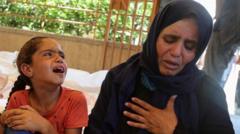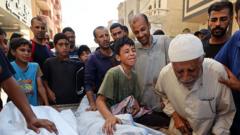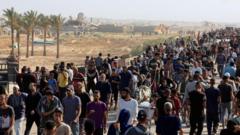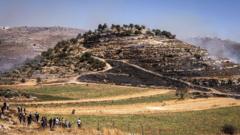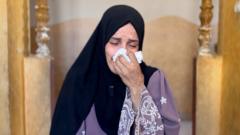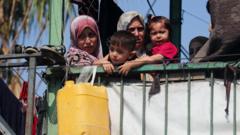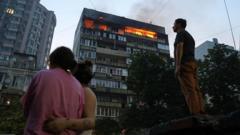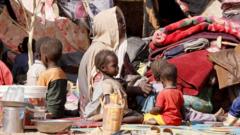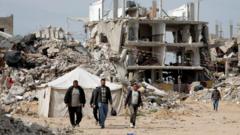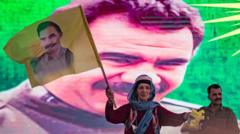With the expiration of a 60-day ceasefire agreement, the complexities of regional politics and military actions raise concerns over stability and potential conflict resurgence.
**Israeli Troops Remain in Southern Lebanon Despite Expired Withdrawal Deadline**
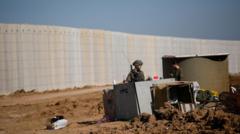
**Israeli Troops Remain in Southern Lebanon Despite Expired Withdrawal Deadline**
The situation in southern Lebanon remains tense as Israeli forces refuse to leave despite a withdrawal deadline passing.
The ceasefire deadline for Israel’s withdrawal from southern Lebanon was reached early Sunday, yet Israeli troops are expected to remain in certain areas. Officials from Israel asserted that the ceasefire agreement has not been fully realized, primarily due to Hezbollah's presence in the region. The deal, negotiated with the assistance of the US and France, aimed to end the 14-month long conflict by facilitating an Israeli retreat and the removal of Hezbollah’s fighters and weapons, while permitting the deployment of Lebanese army troops in territories predominated by Hezbollah for years.
This situation presents a significant challenge for the new Lebanese president, Joseph Aoun, who is striving to stabilize the country. His office indicated on Saturday that there were ongoing discussions concerning Israel’s “dangerous practices” in southern Lebanon. The response from Hezbollah remains uncertain, but any re-ignition of hostilities would likely provoke backlash within Lebanon’s populace.
The conflict, which saw an escalation last September, resulted in Israel conducting intensive airstrikes across Lebanon, the targeted assassination of Hezbollah leaders, and an extensive ground invasion. This violent wave led to approximately 4,000 casualties, encompassing many civilians and displacing over 1.2 million people from their homes.
According to recent statements from Israeli leadership, the withdrawal process is contingent upon the Lebanese army's effective enforcement of the ceasefire and Hezbollah's retreat from areas beyond the Litani River, approximately 30 kilometers from the border. Given that the Lebanese state has not fully executed its part in the agreement, Israeli forces will continue a gradual withdrawal, as confirmed by officials who declined to specify the remaining troop count in Lebanon.
The Lebanese army has reported progress in its deployment efforts along the border but noted "delays" attributed to Israel's hesitance to withdraw. The army also appealed to residents against returning to border regions until the situation stabilizes.
Hezbollah has not publicly declared its response to Israel's continued presence, although the group warned that any failure to adhere to the withdrawal deadline would represent a severe breach of the agreement and a challenge to Lebanese sovereignty. Insiders from Western diplomatic channels suggest that Israel may require additional time to dismantle Hezbollah's remaining infrastructures, proposing an extension for another 30 days for the withdrawal process.
The hesitance displayed by Hezbollah regarding its next moves may illustrate its precarious situation; long seen as a powerful force, the group has faced significant losses during the conflict, including a depletion of its military assets and the deaths of many fighters and leaders.
While the ceasefire has halted violence that caused extensive damage and destruction, allowing many to return home, Hezbollah's potential for renewed aggression could meet profound domestic resistance. Many Lebanese criticize the group for dragging the nation into turmoil contrary to its interests.
Amid this, President Aoun is undertaking ambitious reforms aimed at restoring state institutions beleaguered by corruption, rejuvenating the economy, and addressing arms possession monopoly issues, a move that could involve curtailing Hezbollah's military authority. However, fears persist that any confrontations with the group could lead to internal discord. Israel's overarching aim in its conflict with Hezbollah was to facilitate the safe return of around 60,000 displaced individuals and diminish Hezbollah's power along the northern border—a strategy that gained particular urgency following recent violent episodes that have embroiled the region.
This situation presents a significant challenge for the new Lebanese president, Joseph Aoun, who is striving to stabilize the country. His office indicated on Saturday that there were ongoing discussions concerning Israel’s “dangerous practices” in southern Lebanon. The response from Hezbollah remains uncertain, but any re-ignition of hostilities would likely provoke backlash within Lebanon’s populace.
The conflict, which saw an escalation last September, resulted in Israel conducting intensive airstrikes across Lebanon, the targeted assassination of Hezbollah leaders, and an extensive ground invasion. This violent wave led to approximately 4,000 casualties, encompassing many civilians and displacing over 1.2 million people from their homes.
According to recent statements from Israeli leadership, the withdrawal process is contingent upon the Lebanese army's effective enforcement of the ceasefire and Hezbollah's retreat from areas beyond the Litani River, approximately 30 kilometers from the border. Given that the Lebanese state has not fully executed its part in the agreement, Israeli forces will continue a gradual withdrawal, as confirmed by officials who declined to specify the remaining troop count in Lebanon.
The Lebanese army has reported progress in its deployment efforts along the border but noted "delays" attributed to Israel's hesitance to withdraw. The army also appealed to residents against returning to border regions until the situation stabilizes.
Hezbollah has not publicly declared its response to Israel's continued presence, although the group warned that any failure to adhere to the withdrawal deadline would represent a severe breach of the agreement and a challenge to Lebanese sovereignty. Insiders from Western diplomatic channels suggest that Israel may require additional time to dismantle Hezbollah's remaining infrastructures, proposing an extension for another 30 days for the withdrawal process.
The hesitance displayed by Hezbollah regarding its next moves may illustrate its precarious situation; long seen as a powerful force, the group has faced significant losses during the conflict, including a depletion of its military assets and the deaths of many fighters and leaders.
While the ceasefire has halted violence that caused extensive damage and destruction, allowing many to return home, Hezbollah's potential for renewed aggression could meet profound domestic resistance. Many Lebanese criticize the group for dragging the nation into turmoil contrary to its interests.
Amid this, President Aoun is undertaking ambitious reforms aimed at restoring state institutions beleaguered by corruption, rejuvenating the economy, and addressing arms possession monopoly issues, a move that could involve curtailing Hezbollah's military authority. However, fears persist that any confrontations with the group could lead to internal discord. Israel's overarching aim in its conflict with Hezbollah was to facilitate the safe return of around 60,000 displaced individuals and diminish Hezbollah's power along the northern border—a strategy that gained particular urgency following recent violent episodes that have embroiled the region.

